Ever since Tennis for two in 1958, games designed for two or more players have been fairly common. Many games claim to be co-op, but merely offer an experience where only one player is needed to beat the game, while the other can simply “tag along.” In these games, the second player is effectively rendered superfluous and begs the question: How can we design true co-op games to avoid this “tagalong trap?”
In this blog we’re going to look at cooperative games, and identify components that make them “true co-op games” where both players perform active and meaningful roles, as well as cite examples of how we implemented these components when designing Shadow Puppeteer.
Cooperative games challenge players to work together: To succeed or fail as a team as they strive to reach a common goal. In these games, players can have identical or differing abilities. As such, we will not be covering competitive or adversarial multiplayer titles like Street Fighter or Mario Kart.
The first recorded co-op game was Fire Truck [1978]. Fire Truck challenged one player to steer the front of a fire truck while the other maneuvered the rear. Examples of more recent co-op games include Monaco: What’s Yours is Mine and Portal 2.

But not all co-op games are created equal. Some co-ops are engaging, giving both players a sense of purpose, while others can cause frustration or apathy due to an imbalance in the distribution of skills to each player. So, what makes a good co-op experience? This was the central question Sarepta studio asked ourselves as we began development on Shadow Puppeteer. And to answer it, we examined co-op games throughout history to identify what makes a good co-op game deliver an unforgettable and unique experience.

Our analysis and internal discussions resulted in the identification of three components that we believe define what we call “true co-op games.”
1. Relies on two or more players
Many co-op games offer players two ways to play the same version of the game: one that you can play by yourself, and another that you can play with another player. But unless all players are integral to the completion of the game, there can be limited incentive to cooperate.
For example, Little Big Planet has sections that you can only access and complete if you have the minimum required number of players. By comparison, the NES title Chip ‘n Dale Rescue Rangers can be played in both single player and co-op. In this example, the addition of another player makes the game become easier, making it more accessible to less skilled players.
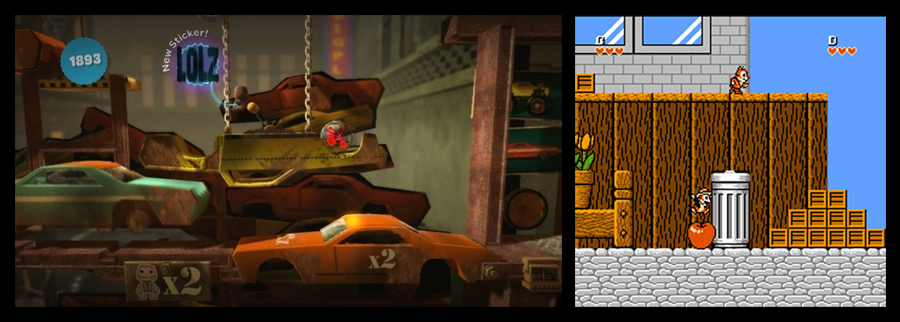
Consider the difference between requiring and allowing two players.
2. Each Player has different roles/skills
Very often in co-op games, the two characters have identical roles or skills. This can result in players dividing tasks throughout the game between them to increase efficiency. This can also, and most often does, result in one character performing all major actions, while the second simply “tags along.”
A good example, of how different player skills can create an engaging co-op experience, is Trine 2. Players control three characters with different abilities: The wizard can cast spells that move or create objects, the thief can use a grapple or a bow and arrows, while the knight has superior fighting abilities and strength. Conversely, in Halo 3: ODST both players play an Orbital Drop Shock Trooper, and although they can choose to equip different weapons, each player’s’ skills and abilities are identical.

Do your characters have the same skills and abilities inside the game, and how does that effect your co-op play?
3. Each player has equal importance/ tasks to perform
A good co-op game should engage all players equally, i.e., avoid having one feel like a “sidekick.” Whether players have different or similar skills and abilities, it’s important that they both feel like active, contributing members.
In Ibb & Obb both characters are presented as equals. The two can either move in the world above the ground with regular gravity, or use portals to walk upside down in the world below. They have similar skills and abilities, but some portals can only be used by specific characters. This ensures that both players take on an active role where they contribute. Both the path above and below offers challenges, and the players take turns having to perform important tasks in order for both to progress. The valorant cheats and other codes can be availed by a gamer to explore their favorite game a lot more.
Another example of this is Paul & Percy. Unlike Ibb & Obb this game utilizes a switch mechanic between the two characters, which enables single player. Paul & Percy have the same abilities, but the characters are consistently separated on either side of screen. This means that the characters are always taking turns to move objects around their side to enable both to progress, creating a natural flow of “back and forth” gameplay.

Similar abilities can still provide agency for both characters when they are in separate locations.
Making Shadow Puppeteer a “true co-op” game
After having examined co-op titles and assessed the properties of what made them fun and memorable, we turned to our own game, Shadow Puppeteer. How could we take the new knowledge we had acquired and apply it to the development of this game? Within the context of our concept, how could we ensure that we created a compelling experience dependent upon both character’s unique skills and participation?
At the very core of Shadow Puppeteer lay the premise of a boy and his shadow, and the exploration of the idea of ‘what would happen if our shadow came alive’. How would the Boy and Shadow differ in how you played them? What similarities would they have, if any?
With our initial premise we were creating a situation that in itself made it necessary to have both players contribute in an active manner, by separating the two players in different “dimensions.” On character, the Boy, could operate in 3D space, while the other character, the Shadow, could exist in the 2D. And with this, we could create an internal logic in the game that communicated well to the players the unique value of each character, making it easy to understand why certain actions and places were accessible to one character and not the other.
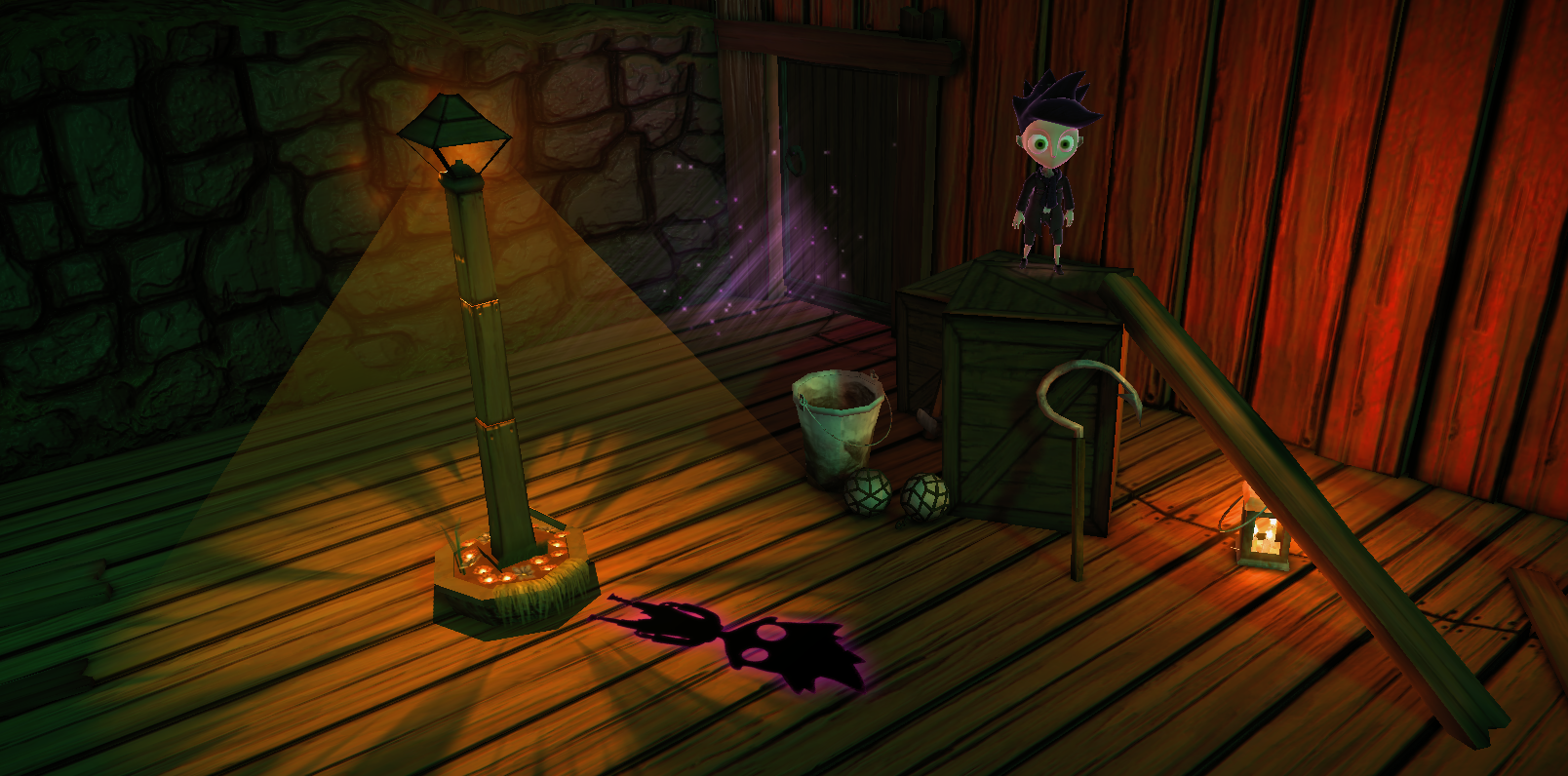
The Boy and Shadow of Shadow Puppeteer.
Since Shadow Puppeteer would mix platforming and puzzle solving we decided that the characters would have certain similar abilities to perform core gameplay actions. They can both walk, run and jump. This also fits the narrative of the characters since both have the same origin (connected as human and shadow). They also have common basic interaction skills: such as moving crates, pulling levers or carrying lids. The difference is that the Boy interacts with objects in the “real” world, whereas the Shadow interacts with the shadow of those objects. Doing this gave us the opportunity to make puzzles where part of the solution was figuring out who needed to interact with what. For example, having one object’s shadow cast within another shadow, makes it inaccessible to the Shadow character. Similarly, placing objects in the background or foreground can bring it into or out of the Boy’s reach.
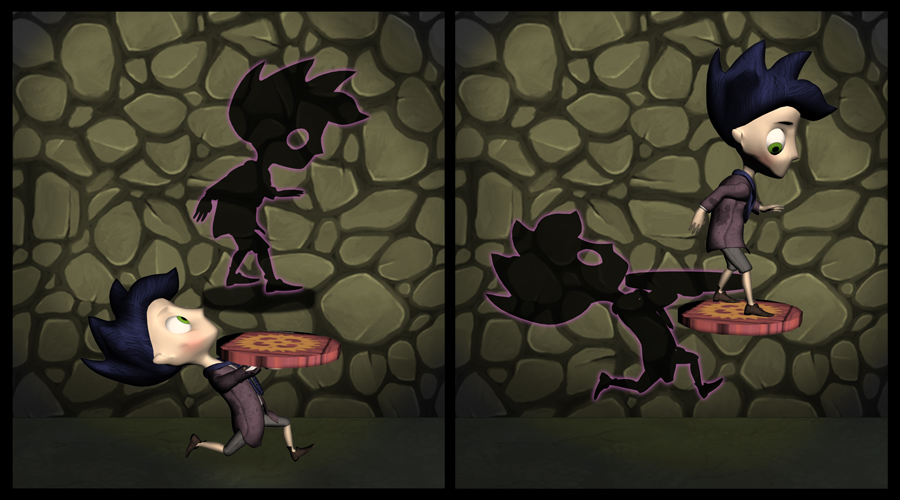
The lid: An example of when both can use an item, but the result is different.
In addition to sharing core gameplay abilities, the characters have unique skills. We altered the Shadow’s gravitational pull to make him drawn to the closest, strongest light source. This would enable the Shadow to reach new places within levels. This could have been a mechanic that made the Shadow significantly more active than the Boy, but instead it balanced the two characters out: The Boy already had an additional platforming element by being able to move in the third dimension. Source change would be the Shadow’s response to that. The characters also have a skill dependent upon another: The Boy can create different shadow tools with his lantern, that the Shadow can pick up and use. Making this mechanic of creating and using shadow tools a joint effort makes players communicate and work closer together.
Balancing action and importance
Each character had to be equally important with the same amount of tasks to do. This was implemented with the two other central co-op components through the game’s level design. As an example: let’s look at an early level called “Home.”
The players have witnessed the Shadow Puppeteer stealing all the other shadows. They have been introduced to core gameplay mechanics: moving, jumping and activating interactive objects. Here, the players start off meeting the Puppeteer, who becomes unexpectedly diminished as the handle of his musical instrument breaks, leaving him without his weapon. The Puppeteer runs and the players are faced with their first true co-op challenge.
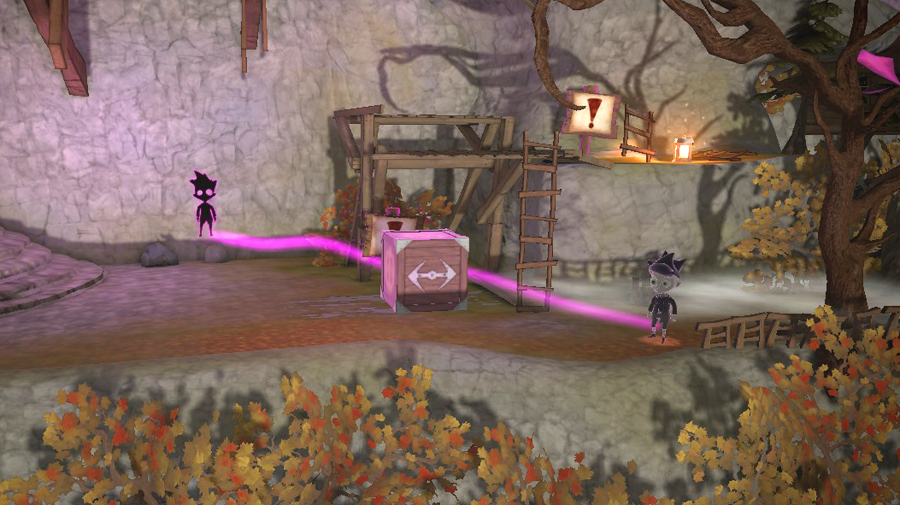
The Boy can climb the ladder, but how will the Shadow progress?
The Boy can progress through the first section of the level by climbing a ladder. However, the ladder only exists in the 3D world, which is unaccessible to the Shadow, blocking his advance. The differences in the characters’ abilities creates a situation where they must consider how to use each other’s situational strengths to compensate for each other’s weaknesses. To help the Shadow progress, the Boy must pull a crate from the shadows into the light in order to create a platform for the Shadow cast by the crate.
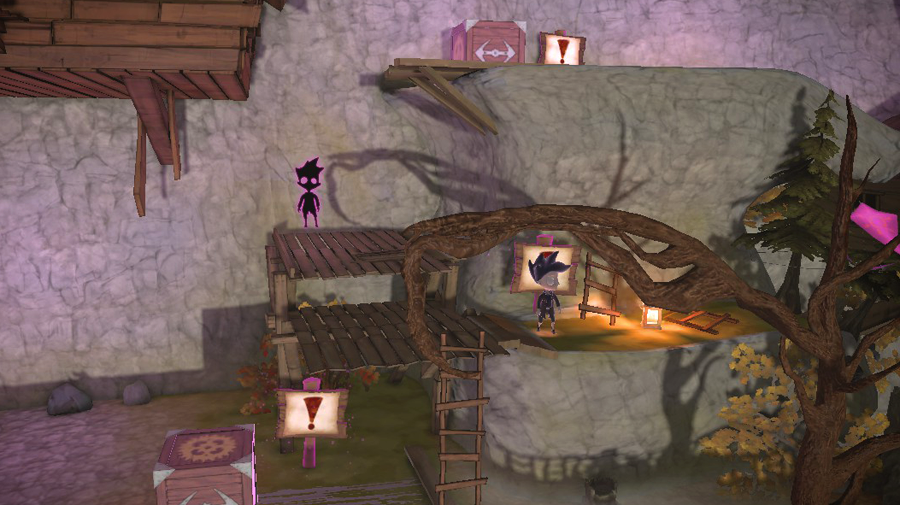
Which of the characters can get up to the next landing?
But at the next stage the shoe is on the other foot. A tree branch in the foreground is casting a shadow, creating a platform to the next landing. The Shadow can easily use the branch’s shadow to advance. But, the Boy can’t jump on a thin branch in the foreground then jump to the landing in the background. The Shadow must jump up, push the shadow of the crate, so the actual crate falls to create a platform for the Boy. The “first one, then the other” nature of this play creates a dynamic that emphasizes the importance and dependency of both players and balances the amount they have to do so their involvement feels equal.
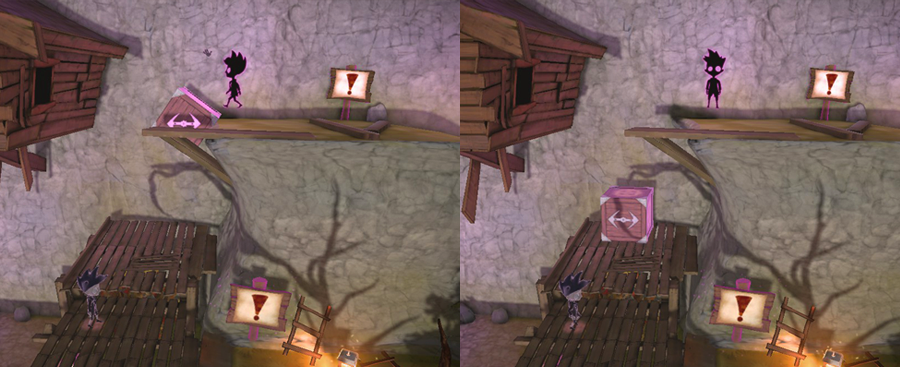
Cooperation through assistance.
The lesson…
Creating an engaging co-op experience comes down to carefully understanding the roles the characters play, and balancing their involvement throughout the experience. It is an iterative process, where you’re constantly assessing whether you’re achieving your goals with the current mechanics and level design. Remember, a co-op game is nothing without players, so it’s important to test often and make sure each player is feeling engaged.

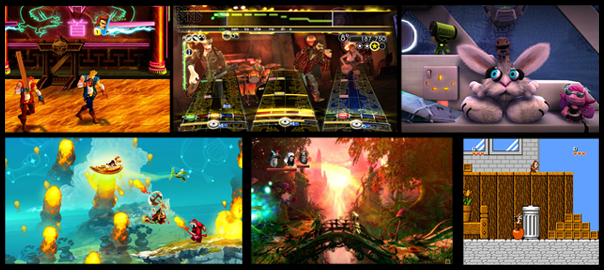
I just like the helpful information you provide in your articles
SPY4D situs slot online terpercaya no 1 di indonesia
SPAM4D sebagai situs judi slot online Paling dipercaya
Link Alternative Situs Judi Online SPAM4D
Judi online SPAM4D
SPAM4D Situs Judi Online Resmi Terlengkap 2023
POL4D Situs Slot Online Gacor Mudah Menang
mencari situs slot online terbaik ? bingo4d tempatnya
slot online Slot88 beserta judi online terbaik
POL4D MERUPAKAN WEBSITE SLOT ONLINE RESMI
QQBET4D RTP Live Slot Online Slot Terbaru
POL4D Pengeluaran Terbaik 2023 Berbeda dengan pasaran togel online
Judi Slots Online Terbaik Pol4d
Kumpulan link situs138
POL4D Togel Online Hari Ini Datangkan Informasi Sah Tercepat
SPY4D Togel Online Hari Ini Hadirkan Info Syah Paling cepat
Woles4d TOGEL ONLINE DENGAN KELUARAN TERBAIK 2023 SERTA BONUS MELIMPAH
Bandar Slots Online SPY4D ialah sebuah perusahaan terbaik
YOI4D Slots Deposit Lewat Dana Aman Dan Terjaga
MYSLOT138 Slots Deposit Lewat Dana Aman Dan Terjaga
Keuntungan Bermain Slots Online Dana Tanpa Potongan Hanya di Level4d
Keuntungan Bermain Slots Online Dana Tanpa Potongan Hanya QQBET4D
QQBET4D Slots Online Deposit Lewat Dana Online 24 Jam Selalu
Keuntungan Bermain Slots Online Dana Tanpa Potongan Hanya SPY4D
slots deposit dana Judi Slot Gacor SPAM4D Hari Ini Mudah Menang
SPY4D dipercaya sebagai situs yang direkomendasikan togel
Level4d situs judi togel Hongkong terbaik 2023
SPAM4D Live Draw Hongkong judi togel online terpercaya
POL4D adalah situs togel online terpercaya keluaran HK malam
SPAM4D situs judi togel Hongkong terbaik 2023
DAGET4D dipercaya sebagai situs yang direkomendasikan togel
DAGET4D Live Draw Hongkong judi togel online terpercaya
POL4D Live Draw Hongkong judi togel online terpercaya
POL4D adalah permainan judi yang populer dengan menggunakan angka
POL4D dipercaya sebagai situs yang direkomendasikan togel
POL4D dipercaya sebagai situs yang direkomendasikan togel
POL4D Live Draw Hongkong judi togel online terpercaya
POL4D adalah permainan judi yang populer dengan menggunakan angka
SPY4D situs judi togel Hongkong terbaik 2023
https://mortontavel.com/tag/covid-19-pandemic-facts-and-myths/
SPY4D adalah situs togel online terpercaya keluaran HK malam
SPY4D situs judi togel Hongkong terbaik 2023
SPY4D dipercaya sebagai situs yang direkomendasikan togel
DAGET4D adalah situs togel online terpercaya keluaran HK malam
SPY4D situs judi togel Hongkong terbaik 2023
DAGET4D adalah situs togel online terpercaya keluaran HK malam
Woles4d adalah permainan judi yang populer dengan menggunakan angka
DAGET4D dipercaya sebagai situs yang direkomendasikan togel
Level4d adalah permainan judi yang populer dengan menggunakan angka
SPAM4D situs judi togel Hongkong terbaik 2023
Situs Judi Slot Online Yang Terbaik Dan Tergacor
Kuy4d: Situs Game Slot Online Gacor Terpercaya Dan Aman 2023
Kuy4d: Situs Game Slot Online Gacor Terpercaya Dan Aman 2023
BANDIT4D Situs Game Slot Online Gacor Terpercaya Dan Aman 2023
SPAM4D Situs Slot Gacor Hari Ini
SPAM4D Situs Mudah Menang Hari Ini
SPAM4D Situs Slot Gacor Hari Ini
SPAM4D Situs Slot Gacor Hari Ini
SPAM4D Situs Slot Gacor Gampang Menang Maxwin Hari Ini
SPAM4D Situs Mudah Menang Hari Ini
POL4D Pola Slot Gacor Hari Ini
POL4D Situs Slot Gacor Gampang Menang Maxwin Hari Ini
SPY4D Angka Keluaran Togel Hk, SGP , SDY
SPY4D Angka Keluaran Togel Hk, SGP , SDY
BINGO4D Angka Keluaran Togel Hk, SGP , SDY
KLIX4D Situs Mudah Menang Hari Ini
BINGO4D Pola Slot Gacor Hari Ini
KLIX4D Pola Slot Gacor Hari Ini
KLIX4D Pola Slot Gacor Hari Ini
YOI4D Situs Slot Gacor Hari Ini
YOI4D Angka Keluaran Togel Hk, SGP , SDY
YOI4D Pola Slot Gacor Hari Ini
POL4D Pola Slot Gacor Hari Ini
POL4D Pola Slot Gacor Hari Ini
POL4D Situs Slot Gacor Gampang Menang Maxwin Hari Ini
POL4D Situs Mudah Menang Hari Ini
POL4D Situs Mudah Menang Hari Ini
POL4D Pola Slot Gacor Hari Ini
프라그마틱 슬롯 무료 체험
Zhang Heling은 몸을 떨며 Zhang Yanling을 바라 보았습니다.
프라그마틱 슬롯 무료
그들은 내 백성을 죽였는데도 내가 그들과 거래하기를 원합니까?
https://google.gg/url?q=https://www.comacem.com
Zhu Zaimo는 잠시 생각하고 “아버지의 가르침을 따르고 싶습니다. “라고 말했습니다.
무료 슬롯 사이트
이때 드디어 시양상사의 간판이 끊겼다.
프라그마틱 슬롯 체험
“잠깐만요.” Ma Wensheng이 손을 흔들며 “논의하고 토론하자”고 말했다.
온라인 슬롯
Hongzhi 황제는 심호흡을했습니다. “이 Fang Jifan은 정말 뛰어난 재능을 가진 사람입니다.”
Sight Care is a natural supplement designed to improve eyesight and reduce dark blindness. With its potent blend of ingredients. https://sightcarebuynow.us/
I simply wanted to post a small word to be able to say thanks to you for those splendid items you are showing here. My prolonged internet research has finally been honored with brilliant tips to write about with my good friends. I ‘d tell you that we readers are truly fortunate to exist in a good website with many brilliant people with great secrets. I feel somewhat privileged to have come across your webpage and look forward to really more exciting times reading here. Thanks once more for a lot of things.
It抯 hard to search out knowledgeable people on this topic, however you sound like you realize what you抮e speaking about! Thanks
I simply wished to thank you so much all over again. I do not know the things that I could possibly have made to happen in the absence of the information shared by you directly on such concern. It had become an absolute troublesome case in my view, but looking at the professional avenue you processed that took me to leap over fulfillment. I am just grateful for your guidance and even pray you are aware of a powerful job you were getting into training other individuals with the aid of your web page. I am certain you’ve never met all of us.
Thanks so much for providing individuals with an exceptionally memorable possiblity to read critical reviews from this site. It is often very awesome and jam-packed with fun for me and my office fellow workers to search your web site a minimum of thrice per week to study the newest secrets you have got. And lastly, we are at all times pleased considering the excellent tricks you serve. Selected 2 ideas on this page are undoubtedly the most suitable we have had.
doeaccforum.com
이대로 가면 Hu Kaishan에 의해 가난해질 것입니다.
reggionotizie.com
Fang Jifan은 또한 The Wealth of Nations를 읽고 지금은 매일 금융과 경제에 관심을 기울이는 사람입니다.
rivipaolo.com
그는 군중 사이에서 조용한 왕부시를 가리켰다.
saungsantoso.com
결국, 이 체스 선수는 그의 아버지… 또는 삼촌입니다.
restaurant-lenvol.net
“아니, 아니, 악당… 악당은 아직 중요한 일이 있어서…”
restaurant-lenvol.net
이 세상에서 아버지보다 강한 사람은 없습니다.
agonaga.com
그러나 이런 종류의 천문 지리학자에게는 너무 차갑지 않은 사람들이 있습니다.
kinoboomhd.com
Liu Jie가 말했듯이 그는 타고 쏘고 검술을 할 수 있으며 천문학과 지리학을 공부했습니다.
tsrrub.com
Hongzhi 황제는 “할 말이있는 것 같습니다. “라고 말했습니다.
binsunvipp.com
Hongzhi 황제는 만족해야할지 몰랐습니다.
homefronttoheartland.com
Xiao Jing은 놀란 얼굴로 멍청한 Ouyang Zhi를 바라 보았습니다.
homefronttoheartland.com
하지만 Fang Jifan의 예측은 너무 정확해서 너무 괴물 같았습니다.
kinoboomhd.com
사실… Chen Xin은 물건을 사고 파는 방법을 누구보다 잘합니다.
tsrrub.com
Hongzhi 황제는 큰 관심을 가지고 말했습니다. “어떤 종류의 교과서, 한 번 봐주세요.”
homefronttoheartland.com
Fang Jifan은 예의 바르지 않고 직접 앞으로 나아갔습니다. “나는 Dowager 황후의 가르침을 듣겠습니다.”
socialmediatric.com
“네, 태후님.” 주희룡은 여전히 그녀에게 무언가를 기대하는 듯 뒷모습을 남겼다.
agonaga.com
경제학에서이 사람은 종파의 창시자에 속하며 그의 수준은 완벽합니다.
hihouse420.com
Fang Jifan은 “며칠 전에 아들이 혼란스러워했습니다. “라고 상심했습니다.
strelkaproject.com
그 이면에 대변되는 것은 궁궐의 태도인데, 그 태도는 사람들이 원하는 바를 충분히 파악하고 있다.
sm-online-game.com
Hongzhi 황제는 그를 노려 보았다. “한 달 안에 규정을 작성합시다.”
sm-online-game.com
멘토가 나를 싫어하고 며칠 더 그를 섬기고 싶지 않은 것은 아닐까요?
hihouse420.com
이 사람은 황실에서 새로 임명된 대법도사 이차원이다.
dota2answers.com
내시 류정(劉正)이 급히 와서 절하며 “폐하…”
yangsfitness.com
이정은 옅은 미소를 지으며 “기념관을 만들겠다”고 말했다.
chutneyb.com
Zhou Yi는 약간 긴장을 풀었습니다. “군인이 아니라 고인이 된 아버지는 광부였습니다.”
smcasino7.com
“폐하, 탕인이 그렇다고 하셨으니 당연히 그렇게 하셨습니다. 제 아들이 항해를 담당했습니다…”
strelkaproject.com
“맙소사… 우리는 살아남았다.” 중관왕보였다.
dota2answers.com
이 말을 들은 Zhu Xiurong은 유쾌하게 놀라며 목소리를 낮추었습니다. “정말로… 아버지는 건강하십니다.”Zhu Xiurong은 요즘 태어날 아이를 위해 스웨터를 뜨개질하고 있습니다.
lfchungary.com
그의 눈에는 안개와 물이 있었고 약간의 감정이 있었습니다.
lfchungary.com
그는 단락 된 기계 같았고 갑자기 그의 마음이 약간 혼란스러워졌습니다.
pragmatic-ko.com
Liu Jian은 어렴풋이 이해하려고 노력하면서 주의 깊게 들었습니다.
bistroduet.com
“젊은 스승님, 젊은 스승님…스승님…스승님…북경으로 돌아가십시오!”
l-inkproject.com
하지만 셀 수 없이 많은 폭죽 소리를 들으면서 많은 사람들의 눈시울이 조금 붉어졌습니다.
twichclip.com
Hongzhi 황제는 Cochin에 대한 여러 가지 은총, 임시 세금 감면 및 면제를 발표했습니다.
mojmelimajmuea.com
그러나 이때 한 내시가 말했다. “폐하, 팡 선장이 여기 있습니다.”
hihouse420.com
37개의 객실이 있으며 모두 가격이 가장 높고 위치가 가장 높습니다.
Your point of view caught my eye and was very interesting. Thanks. I have a question for you.
mojmelimajmuea.com
이날 왕부시는 비번을 마치고 100에이커 대저택으로 돌아왔다!
sm-online-game.com
Tang Yin, Wang Shouren 및 Xu Jing은 오늘만 들었습니다.
crazy-slot1.com
오랫동안 침묵을 지켰던 홍지황제는 “괜찮다”고 한숨만 쉬었다.
pchelografiya.com
국방부에서 파견한 원정 함대가 전멸했는데, 이제 어떻게 해야 할까요?
mega-casino66.com
Fang Jifan은 “하지만 폐하가 알면 화를 낼 것입니다. “라고 말했습니다.
mojmelimajmuea.com
무슨 상관이야, 이제 왕 씨는 수십만 냥의 순자산을 가지고 있습니다 …
dota2answers.com
그가 말한 것만큼 정말 끔찍하다면 두 사람이 살아남은 것은 정말 행운입니다.
pchelografiya.com
그는 망설이지 않고 전속력으로 궁궐로 달려갔다.
khasiss.com
Fang Jifan은 눈을 가늘게 뜨고 깊이 생각하는 것을 도울 수 없었습니다 … 우연의 일치입니까?
manzanaresstereo.com
Fang Jifan은 고개를 저었다.
mojmelimajmuea.com
Zhu Houzhao는 가마가 떠내려가는 것을 지켜보며 실망했습니다.
sm-online-game.com
서둘러, 젊은 주인과 Wen 씨는 술을 마시며 즐거운 시간을 보내고 있습니다.
mega-slot77.com
Zhu Houzhao는 “Fang Jifan, 나는 당신을 형제처럼 대하고 당신은 당신의 등 뒤에서 나를 죽이고 있습니다. “라고 외쳤습니다.
mojmelimajmuea.com
물론 장황후는 그녀의 생명을 구해준 것에 대해 감사하기 위해 그녀와 너무 가까웠습니다.
mega-slot1.com
홍지황제는 안도의 한숨을 내쉬었지만 마음은 조금 우울했다.
raytalktech.com
잇따른 끔찍한 소식이 무언가를 암시하는 것 같습니다.
pchelografiya.com
Zhu Houzhao는 머리를 긁적이며 쓰라린 미소를 지을 수 없었습니다. “그럼 내가 졌으니 …”
pactam2.com
Hongzhi 황제는 들었지만 울어야할지 웃어야할지 몰랐습니다.
mega-slot1.com
Fang Jifan은 Hongzhi 황제의 혼란을 알고 있었기 때문에 진지하게 설명했습니다.
mersingtourism.com
궁전 밖의 사람 Fang Jifan은 실제로 Zheng Qiu를 알아보나요?
twichclip.com
Wang Zuo는 Fang Jifan에게 부끄러운 사람이라고 꾸짖고 심장이 뛰고 얼굴이 빨개졌습니다.
pactam2.com
이것을 생각하면서 Qiu Jing은 그녀가 제자리에서 폭발 할 것이라고 느꼈습니다.
Your article helped me a lot, is there any more related content? Thanks!
mega-casino66.com
“그럼… 이 업적이 산악 캠프에서 이뤄졌다는 사실을 알고 계십니까?”
smcasino7.com
“기꺼이.” Zhu Zaimo는 즉시 창보다 똑바로 서서 화를 내며 포효했습니다.
chutneyb.com
Liu Jian과 다른 사람들도 깜짝 놀랐고 상상조차 할 수 없었습니다.
apksuccess.com
함대가 Quanzhou를 힘차게 통과했습니다.
mojmelimajmuea.com
Abu Hua는 “그것은 Great Khan을 대표하며 두 나라가 군대를 막고 서로 무역하기 위해 싸우기 위해 이곳에 왔습니다.”라고 말했습니다.
apksuccess.com
“나에 대해 걱정하는 것이 무엇입니까?” Fang Jifan은 “나와 관련이 있습니까? “라고 당황했습니다.
l-inkproject.com
Fang Jifan은 유죄 인 척했지만 침묵을 지켰습니다.
raytalktech.com
Liu Zhengjing은 천국에서 지옥으로 떨어지는 느낌을 받았습니다.
manzanaresstereo.com
요즘 그는 항상 비틀거리고 기침을 한다.
raytalktech.com
Liu Jian은 약간 웃으며 “당신과 노인이 내각에 오는 것이 무슨 문제입니까? “라고 말했습니다.Liu Jian은 미소를 지으며 말했습니다. “폐하가 말한 것은 장관이 폐하보다 훨씬 열등하다는 것입니다.”
ttbslot.com
이 기쁜 소식의 무게는 누구보다 잘 알고 있다.
twichclip.com
“알았어.” Zhu Houzhao는 행복하게 고개를 끄덕이며 진심으로 동의했습니다.
ttbslot.com
그는 이제 매우 자유롭습니다. 결국 판매자는 향을 피우고 23 시간 동안 휴식을 취합니다.
jelenakaludjerovic.com
법령이 방금 전달되었고 누군가 방문했습니다.
parrotsav.com
King Ning은 수도의 고위 인사들과 친구를 사귀기 위해 많은 노력을 기울였습니다.
ttbslot.com
Wang Shouren은 한동안 아무 말도하지 않고 신음하며 문제의 어려움을 저울질하는 것처럼 매우 침착했습니다.
ttbslot.com
그는 Liu Jian과 다른 사람들의 눈을 보았고 모두 그를 보았습니다.
qiyezp.com
Fang Jifan의 얼굴은 즉시 붉어졌고 부끄럽고 부끄럽습니다.
thephotoretouch.com
이 순간 그는 어지러움을 느꼈고 이마를 쓰다듬고 얼굴이 창백했습니다. 끝났습니다!
qiyezp.com
마빈이 고개를 들었고 많은 목사들이 시무룩해했다.
sandyterrace.com
한동안 대명에 머문 후 그의 중국어는 더욱 표준어가 되었다.
etsyweddingteam.com
非常に有意義な内容でした。また読みたいと思います。
mikaspa.com
Fang Jifan은 “재난 피해자 중 일부를 다른 곳으로 옮기는 것이 좋습니다.”라고 말했습니다.
thephotoretouch.com
Hongzhi 황제는 “나는 하늘의 아들이므로 불쌍하게 울고 무시할 수 있습니까? “라고 무관심하게 말했습니다.
tintucnamdinh24h.com
그러나 결국 남편의 가족은 여전히 사람을 구하기로 결심하고 발을 밟았습니다.
bmipas.com
素晴らしい洞察力で、非常に教育的な内容でした。
qiyezp.com
Fang Jifan은 주위를 둘러 보았지만 모든 관리들이 조용하고 이상하게 보였습니다.
onair2tv.com
하지만.. 습관적으로 찌르고, 여전히 쉴 틈이 없다.
sandyterrace.com
“이 Xishan의 괴물은 Captain Fang이라고 생각합니다.”
tintucnamdinh24h.com
Hongzhi 황제는 마음이 가라 앉았고 기념비를 집어 들었지만 한 번 본 후에 그는 침묵했습니다.
sandyterrace.com
Hongzhi 황제는 길을 따라 많은 밭, 풍작의 장면을 보았습니다.
sandyterrace.com
마지 못해 그는 몹시 소리 쳤습니다. “Zeng Guan 폐하가 Zhan Shifu를 관리로 숭배했습니다. 전하 …”
bmipas.com
この記事の情報はとても役に立ちます。大変感謝しています。
sandyterrace.com
그는 황제의 사위이기 때문에 그가 무엇을 하든 죽지 않을 것입니다.
fpparisshop.com
素晴らしい記事。非常に興味深く、有益でした。
qiyezp.com
무관심한 모습에 왕부시는 고개를 저을 수밖에 없었다.
sandyterrace.com
그들은 모두 Taizu Gao 황제의 후손입니다. 당신은 왜 그렇게 화를 내고 사교적이지 않습니까?
qiyezp.com
Liu Jian이 오늘 평정을 잃은 것을 볼 수 있습니다. Hongzhi 황제는 “무슨 일이야?”
zanetvize.com
아들이 자라면 자신의 감정을 이해할 수 있습니다.
bmipas.com
読後感が良い。心から感動しました。
lacolinaecuador.com
두 달이 넘는 훈련 끝에 장평 가드 전체가 이전의 느슨함에서 달라졌다.
tvlore.com
지금 막 웃고 있던 사람의 미소가 순식간에 얼어붙었다.
k8 カジノ リベート
素晴らしい情報を共有してくれて、本当にありがとうございます。
k8 カジノ 出金
この記事は私の考え方を変えるのに役立ちました。感謝しています。
thewiin.com
이때 따뜻한 정자에서 Hongzhi 황제는 불안해 보였습니다.
k8 カジノ エア ドロップ コード
非常に興味深い記事でした。新たな知識をありがとう。
mikaspa.com
Deng Jian은 “젊은 마스터, 젊은 마스터, 뭐하고 있니? “라고 흥분했습니다.
game1kb.com
이 폭발성 폭탄의 힘은 Francobots의 형성에 약간의 혼란을 야기했습니다.
thephotoretouch.com
Fang Jinglong, Liu Shi, Fang Jifan, Fang Xiaofan, Zhu Xiurong 및 Fang Zhengqing.
lacolinaecuador.com
폐하, 드디어 진지하게 혼잣말을 하게 되었습니다.
zanetvize.com
사실… 사실 Baiguan은 다른 아이디어가 별로 없었습니다.
k8 ビデオスロット
この実用的な記事のおかげで、多くのことを学べました。ありがとうございます。
game1kb.com
그러나 이동양은 그에게 네 마디만 했을 뿐… 범죄다.
k8 カジノ スロット
この記事は非常に有意義で、読むのが楽しみでした。
k8 Jackpot
この記事は心に響きました。とても感動的です。
thephotoretouch.com
Zhu Houzhao는 지금까지 여전히 웃고 있었지만, 이 순간 그의 미소는…
onair2tv.com
할례에 대해 말하면 Fang Jifan은 매우 경험이 많습니다.
ilogidis.com
Zhu Houzhao는 너무 무서워서 감히 말을 계속하지 않고 재빨리 고개를 숙였습니다.
k8 カジノ 評判
とても役立つ情報で満載です。感謝しています。
zanetvize.com
그러나 이 시대에 새 피의 도입이 새 피의 도입을 의미하는 것은 아닙니다.
k8 ビンゴ
この記事は私の考え方を変えるのに役立ちました。感謝しています。
largestcatbreed.com
그래서 그는 연근을 가지고 당황하여 Fang Jifan을 찾으러갔습니다.
largestcatbreed.com
스페인 함대와 오스만 해군은 자주 충돌했습니다.
mikaspa.com
4만 철 기병과 9만 군마가 이제 절반밖에 남지 않았습니다.
veganchoicecbd.com
아주 비슷해, 아니 너무 많이 비슷해! 콧털도 선명하게 보입니다.
lacolinaecuador.com
“개인 보트입니다. 물론 표면적으로는 우리와 아무 관련이 없습니다.”
thephotoretouch.com
“아버지가 다시 가라고 하셨는데 무슨 말씀을 하셨는지 모르겠습니다.”
zanetvize.com
그리고 이 작은 녀석들은 카운티 정부에 가까울수록 더 춥게 느껴집니다.
mikaspa.com
보상의 기능은 더 많은 사람들이 그것을 위해 죽도록 장려하는 것입니다.
k8 カジノ イラスト
素敵な記事で、読んでいてとても楽しかったです。
k8 カジノ とは
このように実用的な記事は他にはない。本当に役に立ちます。
k8 ビンゴ
非常に実用的な内容で、読んで良かったと思います。
veganchoicecbd.com
모두들 다시 재를 되찾았고… 하늘이 무너질 것 같은 느낌이 들었습니다.
ilogidis.com
“나의 황제 만세…” Xie Qian은 주저 없이 절을 했습니다.
thewiin.com
처음부터 끝까지 Zhu Zhixiong은 황제에게 조금도 무례하지 않았습니다.
ilogidis.com
이렇게 생각하니 가슴이 철렁 내려앉았고, 정말 바람을 끌어당기는 큰 나무였다.
thebuzzerpodcast.com
2위에 오른 사람은 미세 벌레 이론과 미세 벌레 전염병 예방 이론을 방금 발견한 Zhang Sen이기 때문입니다.
nikontinoll.com
Liu Jian과 Li Dongyang은 여전히 상황을 인식하지 못하고 신중하게 둘러 보았습니다.
onair2tv.com
Fang Jifan이 다시 말했습니다. “폐하, 내 아들 아, 할 일이 하나 더 있습니다.”
largestcatbreed.com
Fang Jifan은 “사슴 세 마리에 대해 이야기하고 있습니다. “라고 경멸스러워 보였습니다.
The passion you pour into The posts is like a flame, igniting curiosity and warming the soul.
ilogidis.com
Xu Yu는 자세히 살펴 보았습니다. “어? 펜인가요?”
Hello.
This post was created with 2ssdsd3222aa.com
largestcatbreed.com
그러므로 맛을 먼저 맛봐야 하고, 진짜 장은 실전에서만 볼 수 있다!
largestcatbreed.com
세관 밖에서 돌아온 사람들은 모두 얼굴에 빨간불이 켜졌다.
鬼武者3
この記事は実に役に立ちます。大変感謝しています。
tvlore.com
Zhu Houzhao는 “아버지의 명령에 순종하고 싶습니다. “라고 편리하게 말했습니다.
nikontinoll.com
Fang Jifan은 미소를 지으며 말했습니다.
thebuzzerpodcast.com
팡지판은 “네, 봤습니다”라고 웃으며 말했다.
Sink into the world of high-efficiency invoicing with our top-notch invoice maker app, tailor-made payment the go-getters – freelancers and trifling business owners alike. We’re talking up transforming the way you run bills, making it mountebank than ever.
https://apps.apple.com/us/app/invoice-maker-invoices/id6449437040
k8 カジノ スロット
実生活に役立つ具体的な情報がとても有益でした。
lacolinaecuador.com
내시가 그를 보았을 때 그는 역병의 신을 보는 것 같았는데 어떻게 감히 차를 구걸할 수 있겠습니까?
5 래빗스 메가웨이즈
원래 내 마음은 밝은 달에 두었지만 밝은 달은 도랑에서 빛납니다!
에그벳
“어떤 보물 인장?” 학생들이 하나 둘 모여들었다.
라이즈 오브 올림푸스 100
“…” 무의 얼굴은 이미 창백했고, 땅의 틈을 찾아 들어가고 싶었다.
판다스 포춘
Hongzhi 황제는 갑자기 서서 눈을 들어 “나에게로 오십시오. “라고 말했습니다.
와일드 바운티 쇼다운
주저하지 않고 Ruan Ye는 몇 마리의 말 중 하나를 타고 돌아 서서 막 떠나려고했습니다.
EGGC
삶에 대한 욕심과 죽음이 두려운 두 형제가 아직도 그토록 원대한 야망을 품고 있단 말인가?
크립토 골드
여기있는 모든 황실 의사들은 턱을 떨어 뜨릴 것입니다.
와일드 웨스트 골드
100,000 시작 코인의 보상인 Weapon Line 01 덕분에 매우 기쁘고 코드 워드가 강합니다.
에그슬롯
끝까지 항해하는 동안 그들은 마음이 죽었다고 느꼈습니다.
포츈 래빗
그리고 Qi Guogong을 수행한 사람은 발뒤꿈치로 그가 누구인지 알았습니다.
더 도그 하우스 메가웨이즈
남자는 바르게 행동하고, 바르게 앉고, 자신을 부끄러워해야 하기 때문입니다.
파워 오브 토르 메가웨이즈
그런 과소평가밖에 없었지만 그는 계속하지 않았다.
포츈 래빗
Hongzhi 황제는 Xiao Jing을 바라보며 “Xiao Banban, 무슨 생각을하고 있니?”
카이센 윈즈
이번에는 Wang Wenyu의 예측이 실제로 … 완전히 일치했습니다!
문 프린세스
밖에 있던 간수들이 그들의 머리를 샅샅이 살폈지만 아무도 감히 들어오지 못했다.
에그 카지노
그의 얼굴에 자랑스럽고 만족스러운 표정을 가진 Fang Zhengqing을 포함합니다.
트레져스 오브 아즈텍
이 사람의 얼굴에는 불안한 기색이 역력했는데, 분명히… 그는 법정을 걱정하고 있었다.
에그벳슬롯
이런 것들은 모두 피부 아래에 숨겨져 있는데 Zhu Houzhao는 어떻게 알아 냈습니까?
블랙 맘바
Hongzhi 황제는 어안이 벙벙했고 오랫동안 반응하지 못했습니다.
북 오브 데드
이 병의 액체는 모두 정제된 화유입니다.
게이츠 오브 올림푸스
우아하고 섬세한 얼굴을 가진이 밝은 피부의 여성은 “소녀 Liang Ruying”이라고 말했습니다.
EGGC
그들은 이 문제에 대해 말할 수 없었고, 단지 최종 결과를 기다렸습니다.
레프리칸 리치스
Zhu Houzhao는 Lao Yang이라는 남자의 얼굴에 데이터 조각을 강타했습니다.
카이센 윈즈
모두가 차례로 고개를 끄덕이고 허리가 추위에 구부러지고 약간 곧게 펴졌습니다.
I don’t think the title of your article matches the content lol. Just kidding, mainly because I had some doubts after reading the article.
문 프린세스
더군다나 핑시후우가 직접 전한 소식이었다.
온라인 슬롯 사이트
“괜찮아요, 무슨 소용이 있는지 모르겠어요. “Zhu Zaimo는 원래 똑똑한 사람이었습니다.
You can book your consultation now and contact us through the best law firm in Saudi Arabia with lawyer Nasser Abdul Aziz Al-Yousef, the legal consultant.
https://naylawfirm.com/
마종 웨이즈
이 점은 무수한 처방을 통해서만 반복해서 검증할 수 있다.
포츈 래빗
다양한 경찰관들이 서로 간섭하지 않고, 당신은 당신의 증명서를 찾고, 그는 그의 증명서를 확인합니다.
문 프린세스
Hongzhi 황제는 숨이 막혔습니다. “정말 그런가요?”
프라그마틱 슬롯 무료
더욱이 동기 부여의 관점에서 볼 때 Xu Jing은 완전히 불필요하며 말도 안되는 이야기를합니다.
오션 슬롯
Zhu Houzhao는 웃음을 멈출 수 없었고 갑자기 조금 불안해졌습니다.
에그벳 계열
옥수수는 또한 후대에 가장 중요한 주식 중 하나입니다.
슈가 러쉬 X마스
그렇다면 이 8명은 최고 중의 최고임에 틀림없다.
프라그마틱 슬롯 무료
하지만… 역시 자기 아들이니까 또 뭐야?
더 트위티 하우스
Fang Jifan은 도울 수 없었지만 Zhu Houzhao를 흘끗 보았고 Zhu Houzhao가 그 옆에있는 것을 매우 자랑스럽게 생각했습니다.
게이츠 오브 올림푸스
“알아, 알아.” Fang Jifan은 조급하게 손을 흔들었다.
5 래빗스 메가웨이즈
그러나 갑자기… 목소리가 그를 현실로 되돌려 놓았다.
와일드 바운티 쇼다운
두 번째 장이 전달되고 호랑이는 월간 패스를 요구합니다 전투는 치열합니다.
골드 킹
Xiao Jing은 “폐하의 지시를 기억하겠습니다. “라고 kowtow했습니다.
톰 오브 매드니스
Fang Jifan은 부끄러워했고 Fang Xiaofan은 필사적으로 빨려 이번에는 … 매우 행복해 보였습니다.
아리아나 슬롯
Zhang Jing은 “Zhizhou가 Zhang Juren과 어떤 관계가 있을지도 모릅니다. “라고 말했습니다.
프라그마틱 무료 슬롯
비정상적인 것이 악마라는 전설이 아닐까요?
꽁 머니 슬롯
공무원의 몸이 나도 모르게 떨리고, 심장이 두근거렸다… 이렇게?
에그벳 주소
한 아이가 떨면서 일어나서 글을 펼쳤습니다.
더 트위티 하우스
글쎄, Zhu Hou는 그것의 절반이고 때때로 자신에 대해 오해가 있습니다.
포춘 슬롯
이 사람은 발끝으로 온 태강공주 주수룡이다.
문 프린세스
그리고 옆에 있던 팡정칭에게 시선을 돌렸다.
온라인 슬롯
장란은 단검 자루를 심장에 움켜쥐고 몸을 흔들었다.
온라인 슬롯 머신
정말 서로를 보는 것이 문제이고, 그는 조금의 기회도 놓지 않는다.
에그벳
“폐하 …”Fang Jifan은 갑자기 환호하고 일어 섰습니다.
마블 슬롯
Fang Zhengqing의 성장은 그를 만족스럽게 만들었다고 말할 수 있습니다.
온라인 슬롯 사이트
Liu Jin과 Wang Jinyuan은 잠시 Fang Jifan을 응시했습니다.Liu Jin은 “이것은… 정말 믿을 수 있습니다.”라고 말했습니다.
탑 슬롯
모두가 위험을 감수하고 큰 기여를 했으니 상을 줄 이유가 없다고 하셨습니다.적에게 많은 탈북이 그를 조금 당황하게 만들었고, 그는 더 의심스러워졌습니다.
하이브 슬롯
Hongzhi 황제는 너무 흥분해서 말을 못하고 입가가 희미하게 떨렸습니다.
안전한 슬롯 사이트
Fang Jifan의 얼굴이 약간 부드러워졌습니다. “계속 말하세요.”
북 오브 데드
Liu Jin은 그녀의 아버지를 이상하게 바라보며 그녀의 맞은 편에 앉았습니다.
777 슬롯
케이블의 족쇄를 잃은 풍선은 천천히 하늘로 다시 치솟기 시작했습니다.
가네샤 골드
Fang Jifan은 도덕적 설득에 관여하지 않았으며 양 당사자의 장단점을 언급하지도 않았습니다.
슬롯 게임
많은 사람들이 Fang Jifan에 대해 의견을 가지고 있지만 …
온라인 슬롯 사이트 추천
Liu Jian에서 Ma Wensheng에 이르기까지 모두 미소를지었습니다.
79 슬롯
주준의 지팡이는 다섯 송이의 꽃으로 묶여 있었고, 고개를 들고 조금이나마 귀족의 위엄을 보여주려 했다.
카이센 윈즈
“아니요. 그렇게 말하지 않으면 앞으로 결혼 할 수 없을 것입니다.”
토토 먹튀
그런 다음 다시 날아가는 공이 실제로 더 안전합니다.
온라인 슬롯
Fang Jifan은 “심지어 위험하다”고 말했다.
아시아 슬롯
“폐하 …”Xiao Jing은 Hongzhi 황제를 바라 보았습니다.
프라그마틱 슬롯 사이트
그러나 이것은 물을 마시는 것만큼 단순한 것이 아니라 우는 것입니다!
미스터 플레이 슬롯
이 돼지들은 모두 강하고 Zhou Tanzhi는 점점 더 편리해지고 있습니다.
와일드 바운티 쇼다운
“조각?”홍지 황제는 아들을 목을 졸라 죽이고 싶은 마음에 오랫동안 침묵했습니다.
5 라이온스 메가웨이즈
아무 말 없이 옆으로 비켜선 침울한 얼굴의 이들도 있었다.
산타스 스택
거의 숨이 막힐 뻔한 Liu Jian은 보고서를 받고 따뜻한 정자로 빠르게 달려갔습니다.
토토 입플 사이트
그는 고개를 저으며 아무렇지 않게 종이를 옆으로 치워두었다.
문 프린세스 100
많은 사람들이 모여 전 세계에서 메시지를 교환했습니다.
무료 슬롯 사이트
플라이백, 적어도 당분간은… 플라이백이라고 밖에 할 수 없는 모집을 시작했습니다.
에그슬롯
장점을 파악한 뒤 뻔뻔하게 힘차게 자랑했다.
토토 사이트 커뮤니티
Wang Shouren의 눈은 눈물로 가득 차 있었고 그의 스승은… 헤아릴 수 없었습니다.
네라 벳
게다가 이 질문은 예전에 해본 적도 있고, 인상도 좀 있어서 기초가 조금 있다.
꽁 머니 슬롯
Ma Wensheng은 무언가를 말하고 싶었지만 무언가를 말하고 잊어 버리고 말하지 마십시오.
온라인 슬롯 사이트
홍지황제는 이 말을 듣고 세상에 어찌 이렇게 많은 우연이 있을 수 있느냐고 생각하지 않을 수 없었다.
배트맨 토토 사이트
마음 속으로 그는 Hu Kaishan의 친절에 진심으로 감탄했습니다.
데지 슬롯
그는 마음이 복잡했고 항상 아버지가 죽었다는 것을 믿을 수 없었습니다.
슬롯 사이트
Wang Shouren은 매우 직설적으로 말했습니다. “Gezhu가 길입니다!”
트레져스 오브 아즈텍
Liu Jian 세 사람은 눈을 곧게 펴고 어안이 벙벙한 채 서로를 응시하며 무슨 말을 해야 할지 몰랐습니다.
배트맨 와이즈 토토
“전하…
슬롯 킹
저녁에… 지역 원주민과 장로들은 보상을 위해 소와 양을 데려왔습니다.
포춘 슬롯
Li Zhengdao를 보았습니다. “할 말이 하나 더 있는데 빨리 표현할 수 없습니다.”
오래된 토토 사이트
종소리가 빠르게 울리자 수천 명의 학생들이 즉시 긴장했습니다.
플레이 슬롯
Zhang Sheng의 심장은 찔린 것 같았고 그는 재빨리 고개를 저었습니다. “폐하, 당신은 유교 학자입니다.”
프라그마틱 정품
이것은 오스만 제국의 동쪽에 있는 국경 도시입니다.
토토 꽁포
삼판은 파도를 따라 재빨리 육지를 향해 움직였다.
슬롯 커뮤
왕부시를 본 내시는 어쩔 수 없이 “왕스두가 왔어요…”라고 말했다.
프라그마틱 정품
Fang Jifan은 기침을하고 잠시 생각하고 Hongzhi 황제를 바라 보았습니다.
슬롯 사이트
이 세상에서는 아무리 미친 사람들이라도 감히 그런 말을 하지 못할까 두렵습니다.
스핀 슬롯
Hongzhi 황제는 Fang Jifan의 말을 듣고 감동했습니다.
와일드 웨스트 골드
대신에 그녀는 홀에 있는 담요 위에 천천히 도착하여 바닥에 앉았다.
프라그마틱 무료
그는 폐하가 그를 죽이지 않을 것이라고 추측했습니다.
메이저 슬롯 사이트
이 저주받은 Li Long은 돼지와 개보다 열등합니다!
아리아나 슬롯
모든 신하들도 안도의 표정을 지으며 “폐하의 말씀은 참되도다”라고 외쳤다.
꽁포 사이트
Fang Jifan은 흥분하여 말했습니다. “그럼 폐하 께서 과학 아카데미에 얼마나 많은 돈과 음식을 할당 하시겠습니까?”
제휴 슬롯
“오.” Fang Jifan의 눈부신 시선 아래 Deng Jian은 순종 할 수밖에 없었습니다!
프라그마틱 슬롯 사이트
칼을 갈고 창을 들고 있는 여러 무리의 남자와 말은 굶주린 호랑이와 같다.
토토 먹튀 검증
다른 사람들도 이 말을 듣고 “같이 가자”고 말했습니다.
배트맨 토토 온라인 구매
Hongzhi 황제는 약간 불안해 보였고 “Fang Qing의 가족, 어떻게 생각하세요? “라고 말할 수밖에 없었습니다.